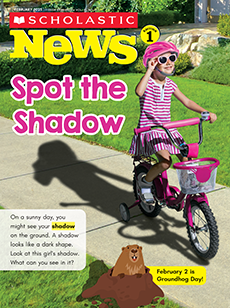A guide for using our resources
Students will compare snow and sand, and determine which has melting properties.
Vocabulary: ice crystals, sturdy, slushy, grains
Science Focus: properties of snow
CCSS (and states that have similar standards): RI.1.1 key details; RI.1.4 vocabulary; RI.1.3 compare and contrast; RI.1.10 informational text; SL.1 participate in conversations
Simple, spectacular ideas to boost your lessons.
Paired Text: Sneezy the Snowman by Maureen Wright
Paired Text: Sneezy the Snowman by Maureen Wright
- After reading the issue, follow this snowman’s hilarious journey as he looks for ways to stay warm. Students will enjoy the repetitive text and the characters’ creative problem solving.
Sounds Hunt: /s/
Sounds Hunt: /s/
- Break off into two groups. One group is assigned the snowman on page 2, and one group is assigned the sandman on page 3. Both groups will reread and circle all the words that begin with the /s/ sound. How many can they find?
- Page 2: snowy, snowman, snowflakes, sky, snowflakes, snow, stack, snowman, sturdy, snowman, sun, snowman, smaller, smaller, slushy
- Page 3: sandy, sandman, sand, stick, sand, sand, sandman, sunglasses, sandman, start, sandman, smaller, smaller
Syllable Game: Melt or Clap!
Syllable Game: Melt or Clap!
- Call out words from the article and have students clap out the syllables. If a word has only one syllable, they can melt to the ground!
- Words: ice, snow, slushy, sunglasses, forever, melt, sand, carrot, crystals, waves.
Hands-On Activity: Have an Ice Race
Hands-On Activity: Have an Ice Race
Skill: predicting, observing, recording results
Materials: Which Will Melt First? skill sheet, pencil, 3 cubes of ice in separate containers, various materials such as: salt, lemon, sugar, paper towel, hot water, baking soda, etc.
- Let students practice making predictions and observations with this ice melting race!
- Give each student a skill sheet.
- Place ice cubes in diff erent containers. Introduce materials (salt, lemon, sugar, etc.). Allow students to record the materials on their skill sheet. Next they will make their predictions. Which material will melt the ice cube first? Which will melt second? Third?
- Invite volunteers to put salt on one ice cube, squeeze lemon over another one, etc.
- Have students write about one body part on their turkey on the sentence strip. Then have them tape the strip to the bottom of the plate to show what they learned!
- Keep the ice cubes somewhere visible and continue checking them after 2 minutes, 5 minutes, 10 minutes, etc. Which ice cube melted fi rst and how long did it take to melt? Students will record results on their sheet and do the same for the other two cubes.
- Have a class discussion comparing students’ predictions and real-life observations!
